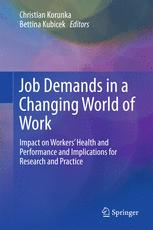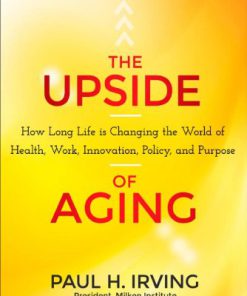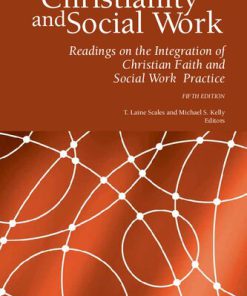Job Demands in a Changing World of Work 1st Edition by Christian Korunka, Bettina Kubicek ISBN 3319546783 9783319546780
$50.00 Original price was: $50.00.$25.00Current price is: $25.00.
Job Demands in a Changing World of Work 1st Edition by Christian Korunka, Bettina Kubicek – Ebook PDF Instant Download/Delivery: 3319546783, 978-3319546780
Full dowload Job Demands in a Changing World of Work 1st Edition after payment

Product details:
ISBN 10: 3319546783
ISBN 13: 978-3319546780
Author: Christian Korunka, Bettina Kubicek
This book examines the new ways of working and their impact on employees’ well-being and performance. It concentrates on job demands and flexible work emanating from current economic and organizational change, and assesses impact on workers’ health and performance. The development of issues such as globalization, rapid technological advances, new management practices, organizational changes and new job skills are addressed. This book gives an overview and discusses the potential negative and positive effects of such new job demands and new forms of work.
Job Demands in a Changing World of Work 1st Table of contents:
1. Job Demands in a Changing World of Work
This section likely introduces the context of contemporary shifts in the world of work, setting the stage for the subsequent discussions. The acknowledgments and references sections indicate a scholarly approach to understanding how work is evolving.
2. Socio-Economic Changes and the Reorganization of Work
- 2.1 Introduction – Overview of the broader socio-economic changes shaping work.
- 2.2 Socio-Economic Trends
- 2.2.1 Financialization – Examining how financial markets influence employment and work structures.
- 2.2.2 Networks Crossing Organizational and National Boundaries – How global networks reshape business operations and employment.
- 2.3 Informatization and Digitalization – Impact of technology on work processes.
- 2.4 Contemporary Changes in Work and Employment
- 2.4.1 Precarization – Rising job insecurity and precarious employment.
- 2.4.2 Boundaryless Work – The dissolution of traditional work boundaries (e.g., between work and home).
- 2.4.3 Work Organization – Subjectification, Standardization, and in Between – The push for individualized work roles and standardized practices.
- 2.5 Summary – Wrap-up of socio-economic changes and their implications for work.
3. The Intensification of Work
- 3.1 Characteristics of Work Intensification – Defining the concept of work intensification, including increased workloads, pressure, and stress.
- 3.2 Global Changes and the Intensification of Work – The role of global economic and technological trends in amplifying job demands.
- 3.3 The Intensification of Work – Now and Then – A historical comparison of how work intensity has evolved over time.
- 3.4 The Effects of Work Intensification on Well-Being and Work Outcomes
- 3.4.1 Work Intensification Within the Job Demands-Resources Model – Analyzing work demands and available resources.
- 3.4.2 Work Intensification Within the Challenge-Hindrance Framework – How work intensity can be both a challenge and a hindrance.
- 3.4.3 The Cognitive Appraisal of Work Intensification – The psychological impact of increased demands.
- 3.5 Strategies and Resources in Dealing with Work Intensification
- 3.5.1 What Can Organizations Do? Job Resources and Organizational Climate
- 3.5.2 WE Will Manage It! Social Support and Work Intensification
- 3.5.3 Is It All About Managing One’s Self? Self and Time Management
- 3.6 Outlook – Future perspectives on managing work intensification.
4. The Bright and Dark Sides of Job Autonomy
- 4.1 Setting the Stage: The Definition of Job Autonomy – Defining the concept of autonomy in the workplace.
- 4.2 The Bright Side of Job Autonomy – The positive effects of autonomy, such as increased motivation and satisfaction.
- 4.3 The Dark Side of Job Autonomy? – Potential downsides, such as stress or confusion from too much freedom.
- 4.4 The Meaning of Job Autonomy in Regulated and Flexible Forms of Work – How autonomy manifests in different work environments.
- 4.5 Beneficial or Deleterious Effects of Job Autonomy? What Makes the Difference?
- 4.5.1 Employees’ Personal Characteristics
- 4.5.2 Constellations of Job Characteristics
- 4.6 Conclusion – Summary of the role of autonomy in modern work settings.
5. Bridges Over Breaches: Agency and Meaning as Resources for Dealing with New Career Demands
- 5.1 Introduction – Introducing the concept of agency and meaning in career development.
- 5.2 The Breach of the Career Contract
- 5.2.1 From Organizational to Individual Responsibility – The shift from employer-driven to self-directed career management.
- 5.2.2 The Bright and Dark Sides of New Career Concepts
- 5.3 The Bridges in Career Paths: The Role of Agency and Meaning
- 5.3.1 The Potential of the Protean Career – A career model that emphasizes flexibility, self-direction, and adaptability.
- 5.3.2 The Protean Career and Its Conceptual Distinctiveness and Measurement
- 5.3.3 Agency, the Protean Career, and Career Resilience
- 5.3.4 Crafting a Meaningful Career
- 5.3.5 Career Agent of One’s Own Life: Employability Through Meaningful Career Narratives
- 5.4 Three Career Narratives: Peaks and Valleys Instead of “Up or Out” – Examples of how non-linear career paths can be successful.
- 5.4.1 First Steps in the Working World
- 5.4.2 Self-Directed and Values-Oriented Career Moves Triggered by Chance Events
- 5.4.3 Reference Groups and Their Role in Career Change
- 5.4.4 Meaning Over Money? Exploring the Perception of Subjective Success
- 5.5 Conclusion – The importance of agency and meaning in navigating career challenges.
6. New Ways of Working and Satisfaction of Psychological Needs
- 6.1 Introduction – Introduction to flexible work arrangements and their impact on employee well-being.
- 6.2 Forms of Flexible Work in Europe – A look at flexible work practices such as telecommuting, flextime, and nomadic work.
- 6.3 Need Satisfaction in the Context of Flexible Work
- 6.3.1 Need for Autonomy
- 6.3.2 Need for Competence
- 6.3.3 Need for Relatedness
- 6.3.4 Need for Structure
- 6.3.5 Need Interdependencies
- 6.4 Designing Flexible Work to Support Need Satisfaction – Leadership and management practices that can help employees meet their psychological needs.
7. The Effects of a Changing World of Work on Daily Working Life
- 7.1 Linking Work Characteristics to Work Outcomes in Daily Working Life
- 7.1.1 Action Regulation Processes – How employees regulate their actions and set goals.
- 7.1.2 Cognitive Appraisal Processes – How employees perceive and react to their work environment.
- 7.1.3 Motivational Processes – The influence of needs and motivation on work outcomes.
- 7.2 The Effects of Changing Work Environments on Within-Person Processes
- 7.2.1 Action Regulation Processes
- 7.2.2 Cognitive Appraisal Processes
- 7.2.3 Motivational Processes
- 7.3 Ambivalent Consequences of Changing Work Environments – Both positive and negative effects of work changes.
- 7.4 Conclusion – Summary of how changing work environments influence employees’ daily lives.
8. Challenges for Job Design
- 8.1 New Demands and New Challenges in a Changing World of Work – Identifying new job design challenges due to changing work dynamics.
- 8.2 Information and Communication Technologies as an Important Part of the Current World of Work – The impact of technology on job design.
- 8.3 Good Theoretical Framework Models for Complexity – Need for models to address complex work structures.
- 8.4 Psychological Needs as a Guideline for Job Design – How psychological theories can guide job design.
- 8.5 The Role of Classic Job Design in a Changing World of Work
- 8.5.1 Motivational Aspects of Work Design
- 8.6 Social Characteristics: Virtualization vs. Personal Contacts – The role of social dynamics in modern job design.
- 8.7 Subjectification: New Challenges for Individuals – The impact of personalized work expectations.
- 8.8 Macro-Level Considerations – The need for information and political strategies in work design.
- 8.9 Final Thoughts – Concluding thoughts on job design in the changing world of work.
9. The Present and Future of Work: Some Concluding Remarks and Reflections on Upcoming Trends
- 9.1 The Reorganization of Work: Intensification, Deregulation, and Subjectification – A final reflection on the trends reshaping work.
- 9.2 The Reorganization of Work and “New” Dividing Lines – How new forms of work create new divides between different sectors and job roles.
- 9.3 Upcoming Trends in Industrial and Service Work
- 9.3.1 The Digitalization and Virtualization of Work
- 9.3.2 The Relocation of Work
People also search for Job Demands in a Changing World of Work 1st:
work changing job description
what job should i do my world of work
changing jobs is uncommon in the modern workplace
the jobs that are in demand or hot change frequently
benefits of changing jobs every few years
You may also like…
Business & Economics - Personal Finance
Religion & Spirituality - Christianity
Politics & Philosophy
Politics & Philosophy - Anthropology
Politics & Philosophy
Computers - Applications & Software
History - World History
Animals & Pets - Animals
Bats in the Anthropocene Conservation of Bats in a Changing World 1st Edition Christian C. Voigt
Business & Economics












